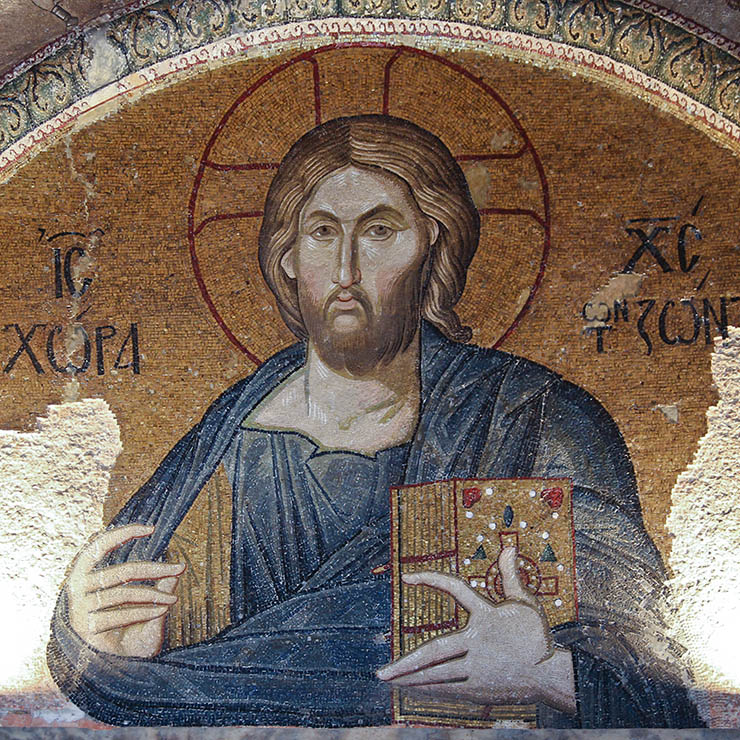 There are a number of images of Christ in the Chora Church, which was dedicated to Christ. The monastery attached to it was dedicated to His mother, the Theotokos. The first mosaics were done in the naos and the work then out into the narthexes. From the work in the naos three panels have survived. Stylistically the work in the main church was the most conservative and it became more mannered - even eccentric - as the artists progressed. It seems that the "iconic" mosaics - like the Pantokrators (Christ is very solid and realistic here) and full length saints - were the most calm and 'classical' in their poses. Even in these one can detect manneristic trends like the broadly spaced fingers in the hand holding the gospel above. Many of the scenes from the lives of Christ and the Theotokos include odd figures in distorted poses that are pasted together like Byzantine clip-art or paper-dolls. These artists must have had sketch books or illustrated books as guides that they picked and chose figures from. One can visualize Theodore and his artists working out the plan and then making adjustments as they were putting up the designs in fresco and then in mosaic on the walls. This was a big, expensive project and speed was probably very important. Mosaics could only be set during the late spring and summer and its possible all of the mosaic work was done in three years.
There are a number of images of Christ in the Chora Church, which was dedicated to Christ. The monastery attached to it was dedicated to His mother, the Theotokos. The first mosaics were done in the naos and the work then out into the narthexes. From the work in the naos three panels have survived. Stylistically the work in the main church was the most conservative and it became more mannered - even eccentric - as the artists progressed. It seems that the "iconic" mosaics - like the Pantokrators (Christ is very solid and realistic here) and full length saints - were the most calm and 'classical' in their poses. Even in these one can detect manneristic trends like the broadly spaced fingers in the hand holding the gospel above. Many of the scenes from the lives of Christ and the Theotokos include odd figures in distorted poses that are pasted together like Byzantine clip-art or paper-dolls. These artists must have had sketch books or illustrated books as guides that they picked and chose figures from. One can visualize Theodore and his artists working out the plan and then making adjustments as they were putting up the designs in fresco and then in mosaic on the walls. This was a big, expensive project and speed was probably very important. Mosaics could only be set during the late spring and summer and its possible all of the mosaic work was done in three years.
The first Pantokrator I will discuss is the monumental one over the door into the inner narthex. This is the first image one sees as you enter the church. The inscription reads "Jesus Christ, the dwelling-place of the living". The panel is huge, 12 feet wide and over 7 feet tall. Christ's face is 2.5 feet tall. The flesh tones used in the face are marble in shades of white and pink and quite small. The shadows are in green and pale blue glass. His tunic and himation are both made in four shades of ultramarine glass with the folds outlined in black glass. The hair and beard are made of glass in a number of shades light brown and white.
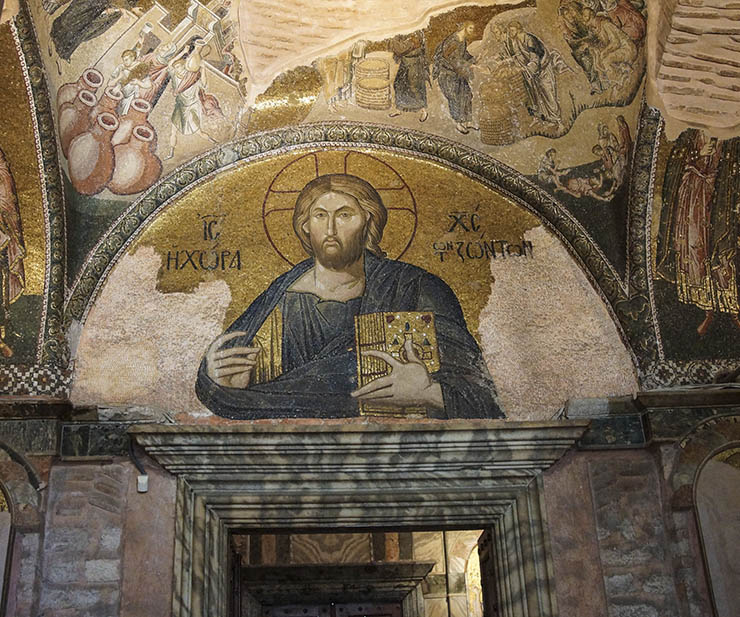 I have always been struck by the number of figures with blond hair in the mosaics here. 'Blond" Christ has been seen before - in Norman Sicily. I have always assumed that mosaic was not an innovation, but must have copied some Byzantine prototype in Constantinople. Was the famous image of Christ on the Chalke gate of the Great Palace fair-haired? Was there a cultural trend in Byzantium that associated blond hair with beauty and did that extend to images of Christ and the saints? Starting with the Komnenian dynasty the Emperors of Byzantium married foreign princesses who were blond. john II married the famously blond Piroska of Hungary - who was Franco-Germanic in her ancestry.We don't know how many of her children were blond, but certainly her youngest son, Manuel I, was not. His images of Christ show Him with dark hair and beard, looking like Manuel himself, no accident since Manuel's name meant "Emmanuel'- "God with us" and he emulated the physical image of Christ in his own representation. The great mosaic of the Deesis in Hagia Sophia is an example of this.
I have always been struck by the number of figures with blond hair in the mosaics here. 'Blond" Christ has been seen before - in Norman Sicily. I have always assumed that mosaic was not an innovation, but must have copied some Byzantine prototype in Constantinople. Was the famous image of Christ on the Chalke gate of the Great Palace fair-haired? Was there a cultural trend in Byzantium that associated blond hair with beauty and did that extend to images of Christ and the saints? Starting with the Komnenian dynasty the Emperors of Byzantium married foreign princesses who were blond. john II married the famously blond Piroska of Hungary - who was Franco-Germanic in her ancestry.We don't know how many of her children were blond, but certainly her youngest son, Manuel I, was not. His images of Christ show Him with dark hair and beard, looking like Manuel himself, no accident since Manuel's name meant "Emmanuel'- "God with us" and he emulated the physical image of Christ in his own representation. The great mosaic of the Deesis in Hagia Sophia is an example of this.
Manuel married twice, both times to Frankish-Germanic Princesses. The first one was Bertha of Sulzbach and the second was Maria of Antioch. Maria was very, very blond and fair. Manuel was very attracted to her and liked all things from Western Europe and spent much of his time in the company of them. Bertha had a girl that survived and Maria had a son. There are no surviving portraits of either of them so we don't know if they were blond, but we can be sure that the general public and the ruling elite thought being blond and fair-skinned was beautiful. On the other hand the people of Constantinople resented the influence and power Westerners had in the Empire, which Manuel and other emperors exploited when it suited them. The problem was with Italians who moved to Constantinople as merchants, shopkeepers, tavern operators and landlords, occupying whole districts in the city. Many of them became "Byzantine" themselves, marrying into local families and assimilating into city life.
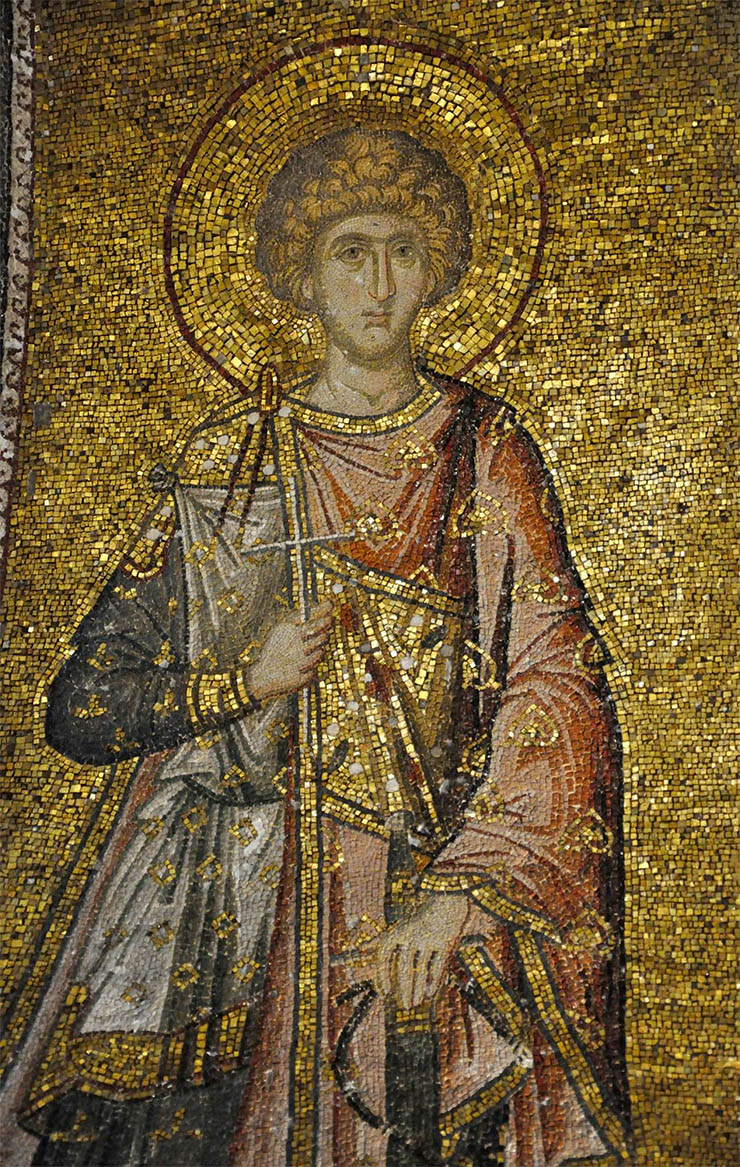 The bushy, blond-headed saint from the Chora strangely does not have a name. It is thought to be Saint George of Cappadocia. He is life-sized, 6 ft tall.
The bushy, blond-headed saint from the Chora strangely does not have a name. It is thought to be Saint George of Cappadocia. He is life-sized, 6 ft tall.
Huge armies of Western Crusaders passed through Constantinople on their way to the east and the Holy Land. The citizens of Constantinople saw masses of them who made their way into the city. They admired the "Latins" for their physical beauty and, since the Latin armies had a large number of female warriors and the men traveled with their families and camp followers. In 1147 the French King Louis VII and his wife the young and beautiful Eleanor of Aquitaine visited Constantinople as the guests of Manuel I. They had a large entourage who traveled with them. Eleanor was much admired. She was compared with Penthesilea, mythical queen of the Amazons, by the Byzantine historian Nicetas Choniates. He added that she gained the epithet chrysopous (golden-foot) from the cloth of gold that decorated and fringed her robe. Golden robes, golden haired - all things - especially people - were thought beautiful and desirable. That this is reflected in the golden-haired Christ of Cefalu is without a doubt.
After the fall of Constantinople in 1204, when the Byzantine emperors recovered their city from the Latins they had several more generations of western brides. By the time of Andronikos II the emperors and their children were themselves blond. In the mosaics of the Chora we see many very blond - not just fair haired but white blond - saints. The Christ in the sanctuary is very blond, too. In this Pantokrator Christ 's beard and even his eyebrows are blond. Is this because the Byzantines of the time thought Christ was blond? Or was it simply the artist and his patron wanting the "most beautiful" Christ based on the fashion of the time? Was their a subtle to effort to make Christ and the emperor resemble each other? I am certain that the blond saints are "portraits" of members of Andronikos's family.
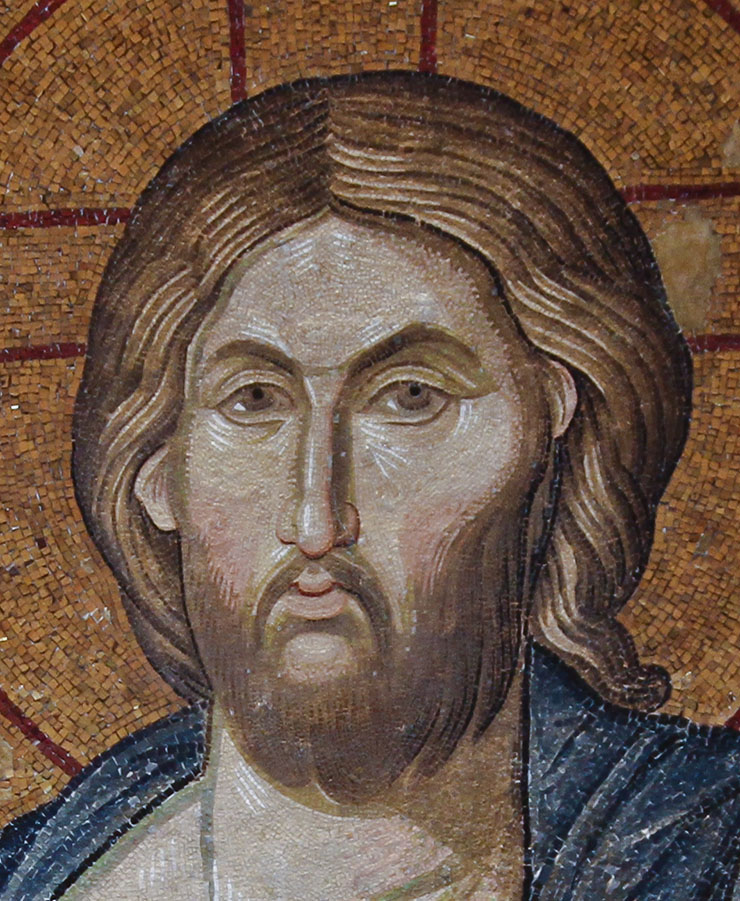 Here we can see the few black lines drawn into the beard of Christ. The only other black in the face are the pupils. This is a very young Christ, with a full unlined face. The absence of black lines in the beard is one of the reasons He looks so blond. The nose is large and strongly drawn, there is a bold shadow alongside it.. The lips are pale and the lower lip projects outward. The line of the lips is boldly drawn. Normally the lines of the eyelids would be drawn in red, here there is no color in them. there is also a strong shadow on the neck.
Here we can see the few black lines drawn into the beard of Christ. The only other black in the face are the pupils. This is a very young Christ, with a full unlined face. The absence of black lines in the beard is one of the reasons He looks so blond. The nose is large and strongly drawn, there is a bold shadow alongside it.. The lips are pale and the lower lip projects outward. The line of the lips is boldly drawn. Normally the lines of the eyelids would be drawn in red, here there is no color in them. there is also a strong shadow on the neck.
The artist has had to use stripes in the transitions from shadow on both sides of the face. One very strange thing is that the right hairline and ear are much higher than the left. There is no obvious explanation for this other than it was a mistake in the drawing that was completed in mosaic before it was noticed. Maybe two artists worked on the face side-by-side. The only other explanation is that this intentionally copies a prototype. I think it is just a mistake.
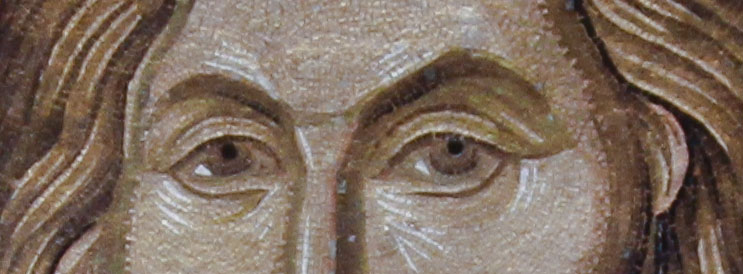 The eyebrows are blond, too - they are arched which makes the face look a bit menacing. notice the checkerboard shading.
The eyebrows are blond, too - they are arched which makes the face look a bit menacing. notice the checkerboard shading.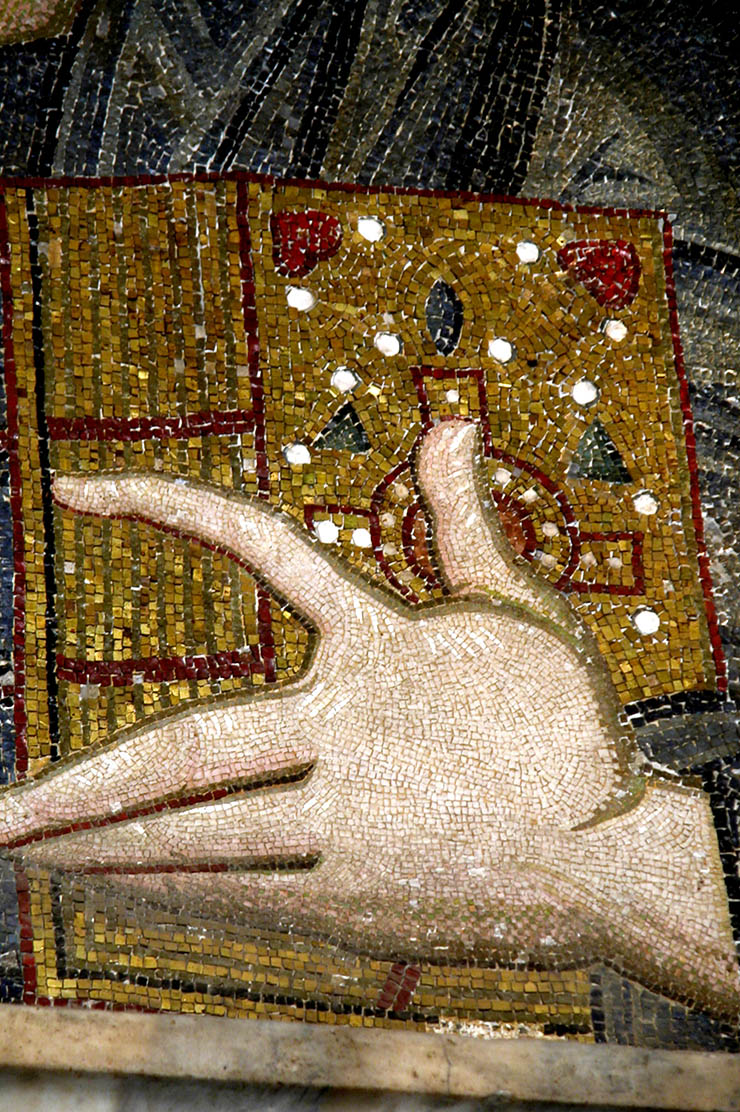 Notice how the artist has used checkerboard stripes to indicate the transition between greenish glass shadows and light flesh made of marble cubes. the hands are massive and fleshy.
Notice how the artist has used checkerboard stripes to indicate the transition between greenish glass shadows and light flesh made of marble cubes. the hands are massive and fleshy.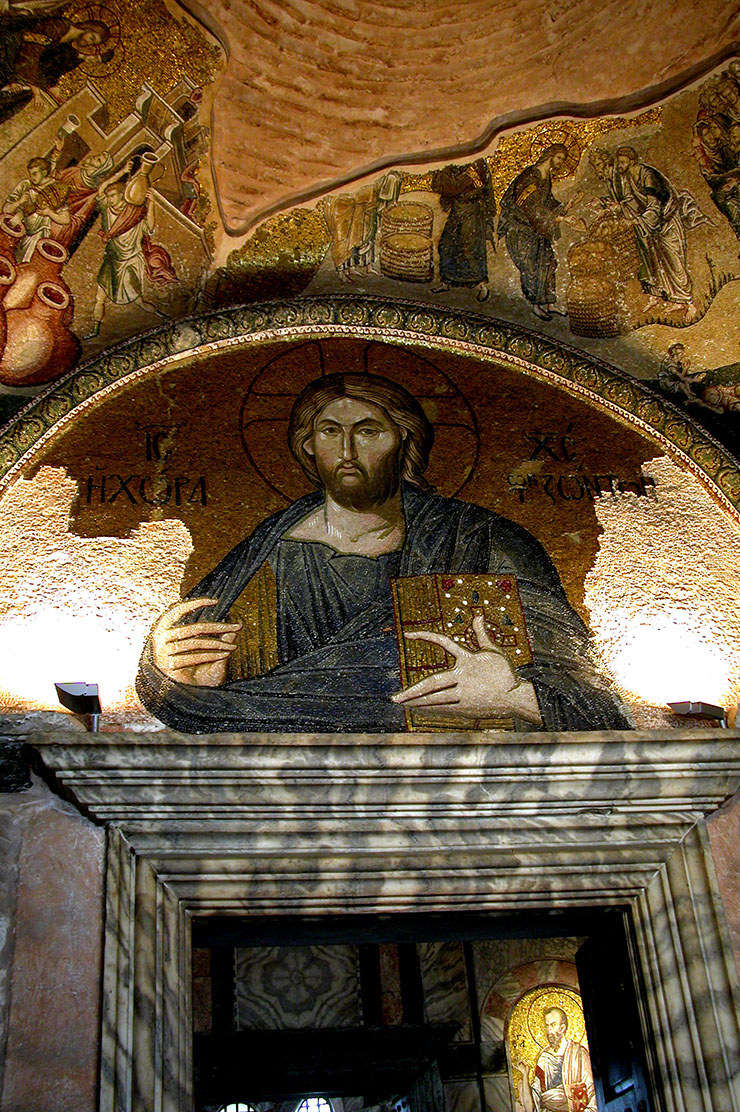 Above you can see how the highlights show up in raking light. The white cubes are matte and stand out against the surface of the rest of the face. This was intentional. The image was lit by by lamps in Byzantine times. Most of the time visitors would have seen the image in natural light.
Above you can see how the highlights show up in raking light. The white cubes are matte and stand out against the surface of the rest of the face. This was intentional. The image was lit by by lamps in Byzantine times. Most of the time visitors would have seen the image in natural light.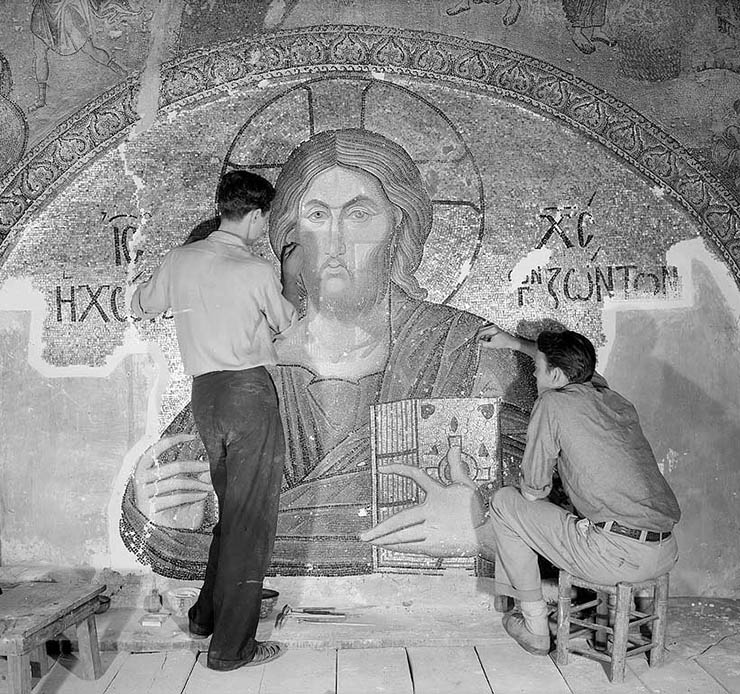 This image of restorers working on the mosaic of the Pantokrator shows how big it is. It's similar in size to the mosaic of Christ in the gallery of Hagia Sophia. The image below shows a drawing taken directly from it. The Byzantine Institute started it's work in the Chora which continued until 1958.
This image of restorers working on the mosaic of the Pantokrator shows how big it is. It's similar in size to the mosaic of Christ in the gallery of Hagia Sophia. The image below shows a drawing taken directly from it. The Byzantine Institute started it's work in the Chora which continued until 1958.
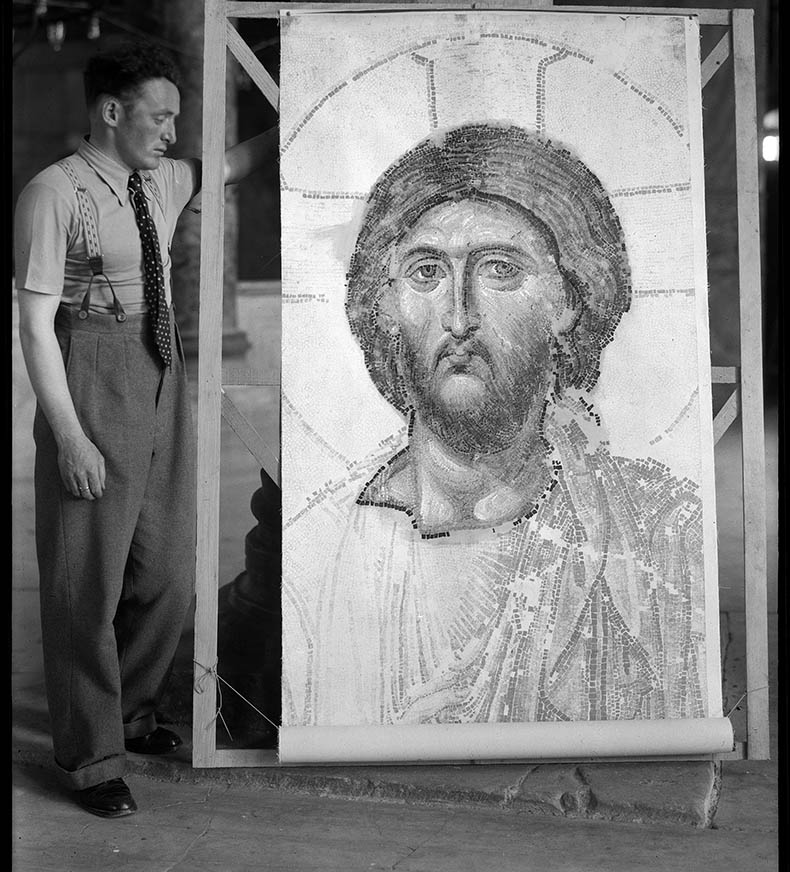 The white highlights stand out here as well.
The white highlights stand out here as well.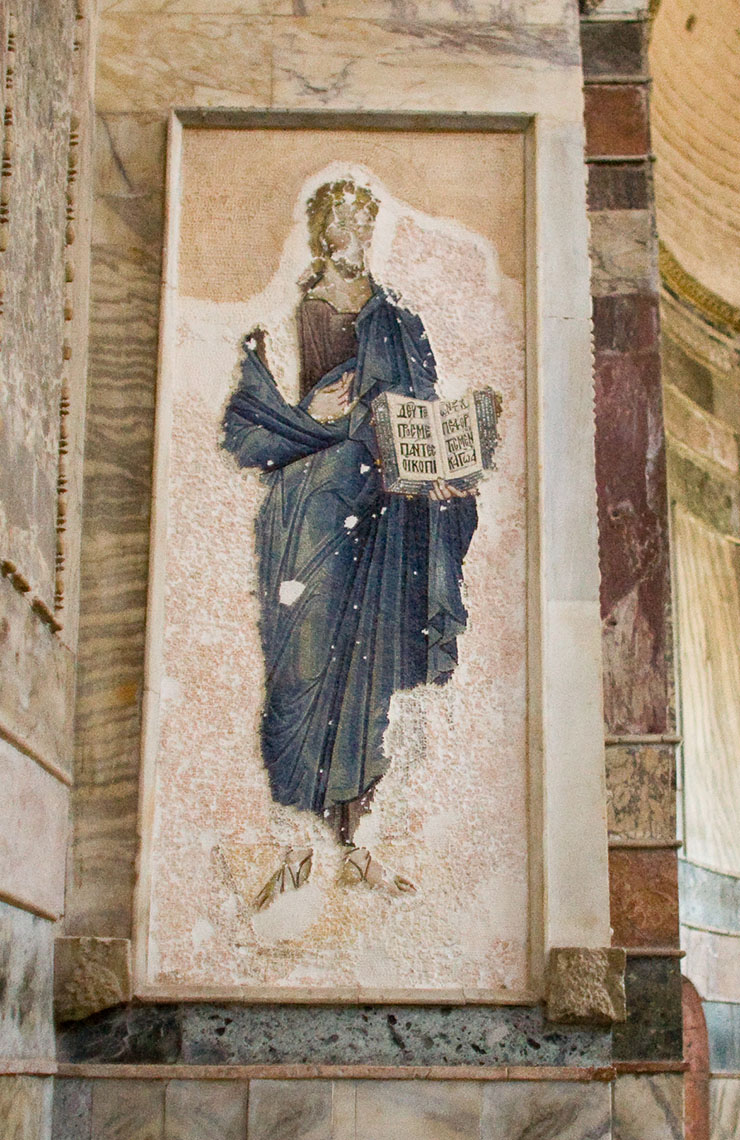 This large - 6.5 feet tall - templon mosaic carries the inscription - "Jesus Christ, the dwelling place of the living". The gospel carries the inscription "Come unto me, all ye who labor and are heavy laden, and I will give you rest" (Matt 11:28). It is in the main body of the church and was set up on the left pier. It was originally surrounded by a marble frame or kiot that has almost entirely been removed. This mosaic icon was connected to the - now vanished - sanctuary screen of the church. It was badly damaged by Muslim extremists after the conversion of the church to a mosque after 1453. The revetment surrounding the icon was also damaged and reset. At the bottom of the kiot you can see two Byzantine marble carvings whose images of saints have been chipped away. The gold background has also been picked at for souvenirs for tourists. This practice was also prevalent in Hagia Sophia and resulted in the complete striping of gold mosaic from the Room over the Vestibule.
This large - 6.5 feet tall - templon mosaic carries the inscription - "Jesus Christ, the dwelling place of the living". The gospel carries the inscription "Come unto me, all ye who labor and are heavy laden, and I will give you rest" (Matt 11:28). It is in the main body of the church and was set up on the left pier. It was originally surrounded by a marble frame or kiot that has almost entirely been removed. This mosaic icon was connected to the - now vanished - sanctuary screen of the church. It was badly damaged by Muslim extremists after the conversion of the church to a mosque after 1453. The revetment surrounding the icon was also damaged and reset. At the bottom of the kiot you can see two Byzantine marble carvings whose images of saints have been chipped away. The gold background has also been picked at for souvenirs for tourists. This practice was also prevalent in Hagia Sophia and resulted in the complete striping of gold mosaic from the Room over the Vestibule.
The modeling of the blue robes of Christ is really amazing. There are five values of blue glass in His himation - that is the reason. Highlights in blue robe are made of gray cubes and are very naturalistic. There are many subtle uses of shades of blue in various shadows. In the Chora only the robes of Christ and the Theotokos are done in ultramarine blue glass which was rare and expensive.
His tunic is composed of violet glass in four values. This would have been one of the primary images of Christ in the sanctuary and the one closest to worshipers in the church. As such it would have been much venerated. There would have been a large candle stand in front of it and places for people to leave candles. During Ottoman times the icon of Christ and the Theotokos on the opposite side were covered with wooden shutters. The battered figures were also covered with layers of lime-white washes.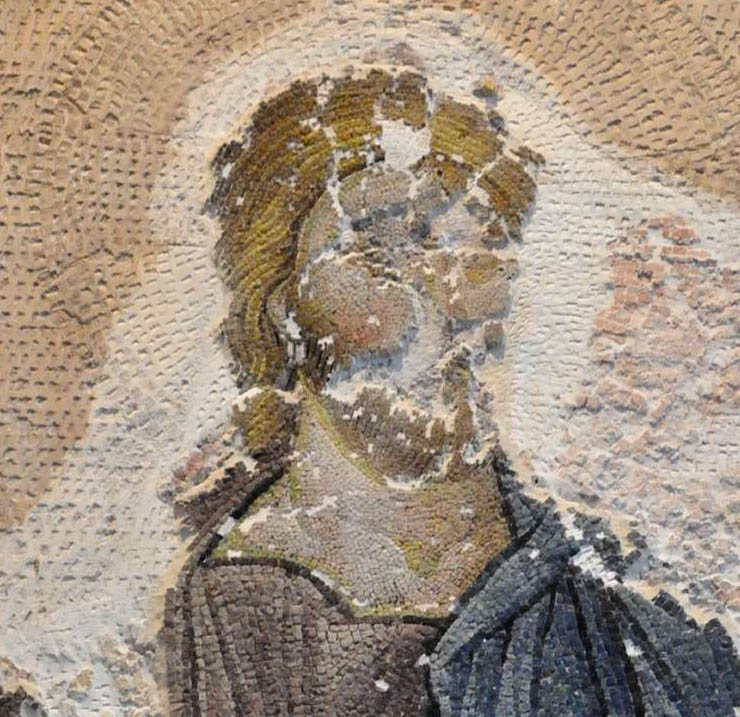 Here - in the much mutilated face - we can see the blond hair of Christ.
Here - in the much mutilated face - we can see the blond hair of Christ.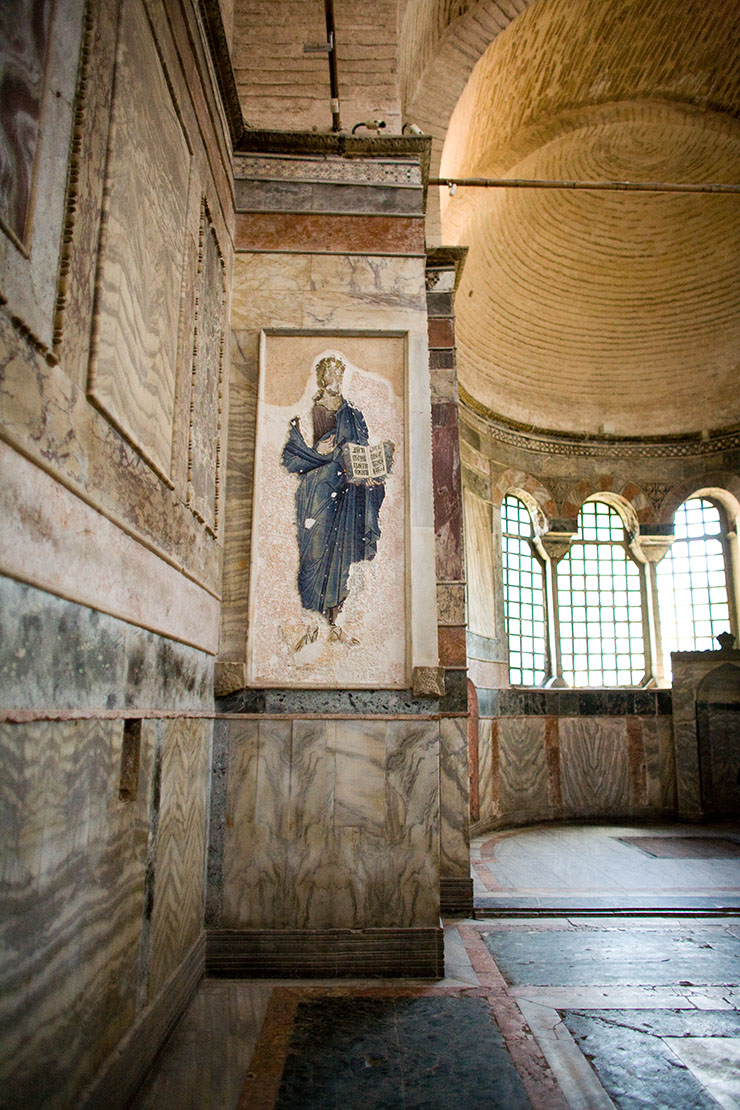 The almost miraculous survival of the icon in its mutilated state reminds Christians of the suffering of Christ in the passion story. The deliberate attacks on the face echo the mocking and beating of Christ by Roman soldiers.
The almost miraculous survival of the icon in its mutilated state reminds Christians of the suffering of Christ in the passion story. The deliberate attacks on the face echo the mocking and beating of Christ by Roman soldiers.
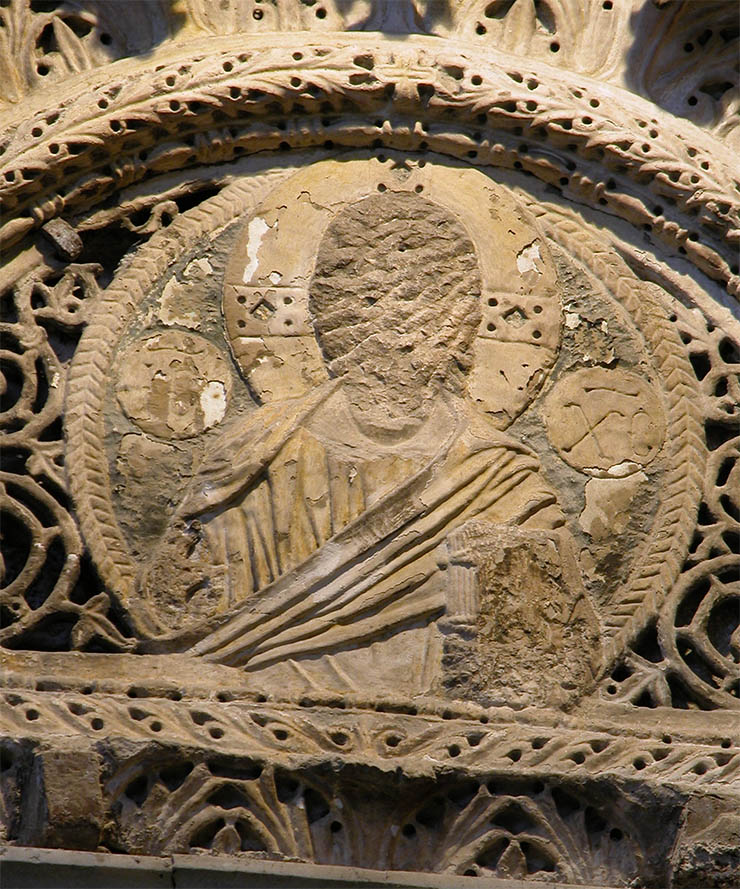 Above you can see a marble carving from the Chora that was a part of a kiot. It is above the mosaic of the templon Theotokos in the nave. These sculptures were originally painted and gilded. Semi-precious stones or glass was inlaid in Christ's halo. Behind the figure of Christ you can see the faded traces of blue. After the Islamic conquest of Constantinople in 1453 the face, hands and gospel of Christ were brutally chiselled away.
Above you can see a marble carving from the Chora that was a part of a kiot. It is above the mosaic of the templon Theotokos in the nave. These sculptures were originally painted and gilded. Semi-precious stones or glass was inlaid in Christ's halo. Behind the figure of Christ you can see the faded traces of blue. After the Islamic conquest of Constantinople in 1453 the face, hands and gospel of Christ were brutally chiselled away.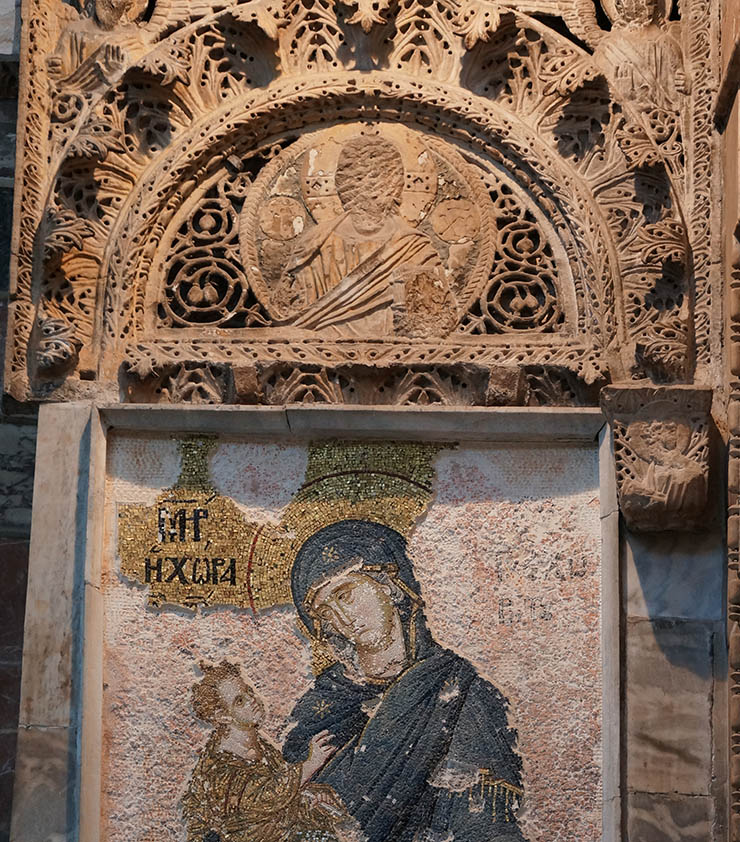
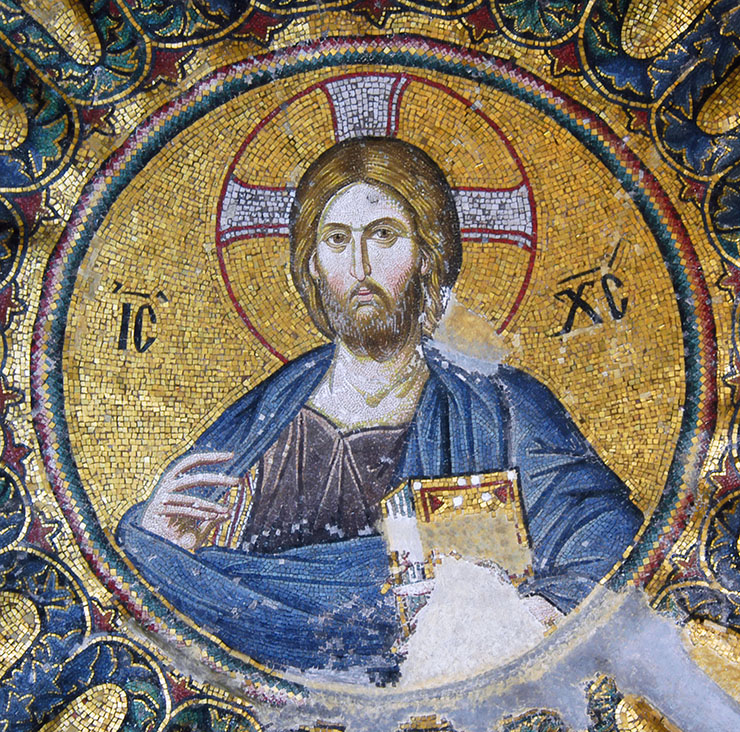 Here is an image of Christ from one of the narthex domes of the church.
Here is an image of Christ from one of the narthex domes of the church.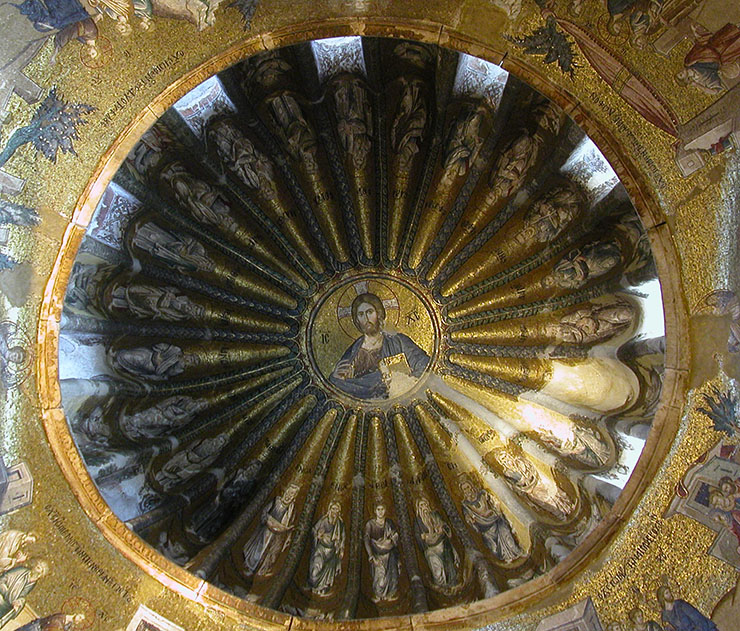 The gold mosaic in the dome glitters. The saints in the coves of the dome are the ancestors of Christ. The curve of the coves creates flames of light between them and Christ in the summit of the dome.
The gold mosaic in the dome glitters. The saints in the coves of the dome are the ancestors of Christ. The curve of the coves creates flames of light between them and Christ in the summit of the dome.
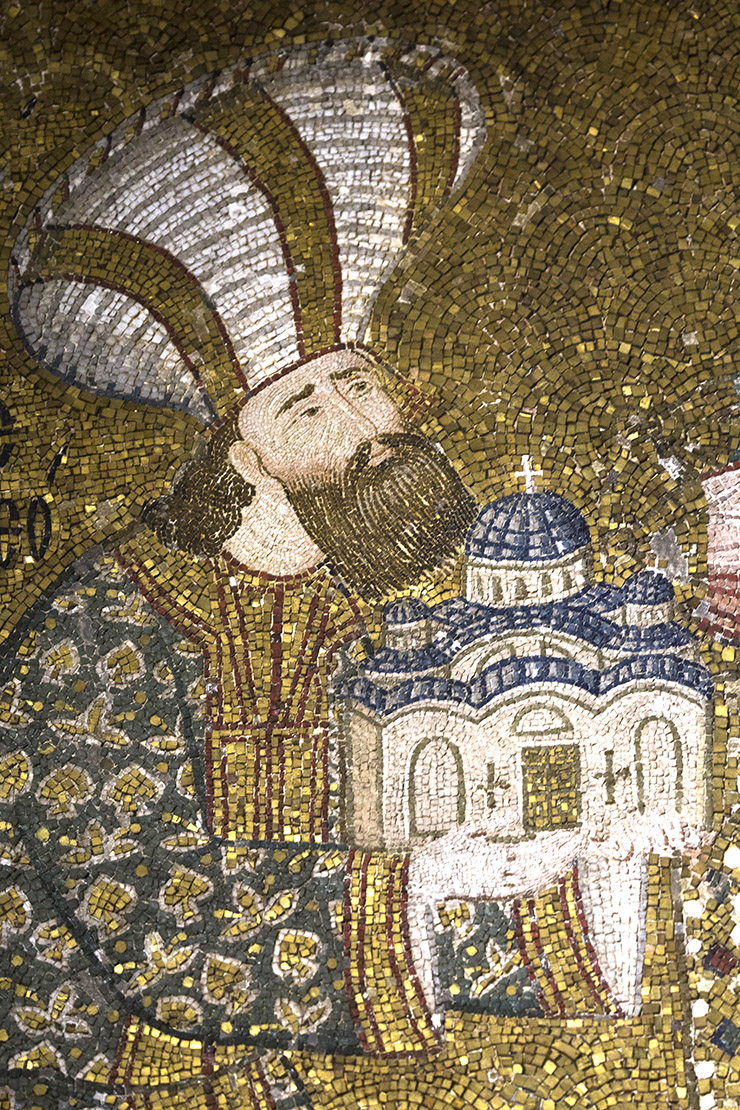 Theodore Metochites was a Prime Minister - Grand Logothete of the Genekon - to Andronikos II. Here we see him presenting a model of the church to Christ Pantokrator. Theodore commissioned the decoration of the church and was closely involved in the planning of the scenes and the individual saints to be used. He was removed from power after riots in the city that ended up in the burning of his palace with all its treasures. He was forced into exile and eventually found his way back to the Chora where he became a monk taking the monastic name of Theoleptos. He died in 1332 and was buried in the tomb he had built for himself in the Chora.
Theodore Metochites was a Prime Minister - Grand Logothete of the Genekon - to Andronikos II. Here we see him presenting a model of the church to Christ Pantokrator. Theodore commissioned the decoration of the church and was closely involved in the planning of the scenes and the individual saints to be used. He was removed from power after riots in the city that ended up in the burning of his palace with all its treasures. He was forced into exile and eventually found his way back to the Chora where he became a monk taking the monastic name of Theoleptos. He died in 1332 and was buried in the tomb he had built for himself in the Chora.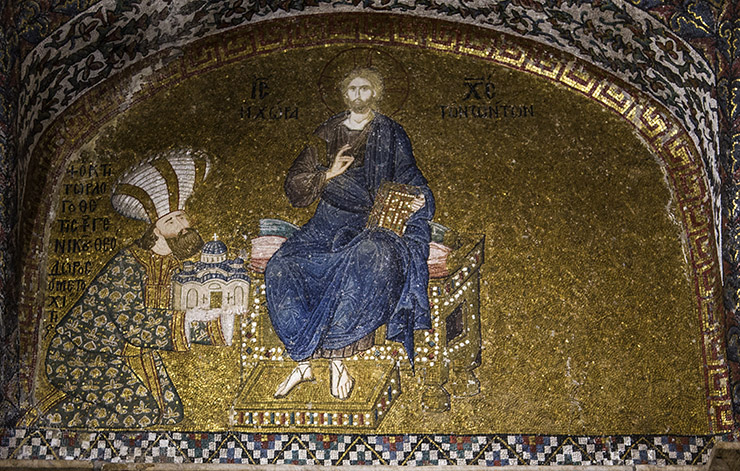 Theodore is wearing a silk kabbadion - kaftan - thickly embroidered with gold thread. In Theodore's time officials of the Imperial court were no longer required to wear silk uniforms of specific cut and color. You could wear what you liked as long as it was luxurious and suitable for court. Theodore wears a large silk turban called a skaidion which literally means sunshade. Even though you could pick your own clothes, hats were dictated by your position. The Byzantines invented the turban which was then taken on by the Ottomans. Theodore has a light brown beard which is cut straight across. His hair is the same color and falls in curls on his neck. Byzantine men were particular about the style and cleanliness of their hair and used scent in it.
Theodore is wearing a silk kabbadion - kaftan - thickly embroidered with gold thread. In Theodore's time officials of the Imperial court were no longer required to wear silk uniforms of specific cut and color. You could wear what you liked as long as it was luxurious and suitable for court. Theodore wears a large silk turban called a skaidion which literally means sunshade. Even though you could pick your own clothes, hats were dictated by your position. The Byzantines invented the turban which was then taken on by the Ottomans. Theodore has a light brown beard which is cut straight across. His hair is the same color and falls in curls on his neck. Byzantine men were particular about the style and cleanliness of their hair and used scent in it.
Silk was still being made in Constantinople but foreign competition had destroyed the local luxury production of it. The best silk came from distant China, but the primary source for it was now Italy. There was still a large domestic market for low-cost silk.
It is possible that this mosaic intentionally refers to the image of Christ in the Deesis mosaic of Hagia Sophia. The gold background is set in a similar lobed shell-like pattern.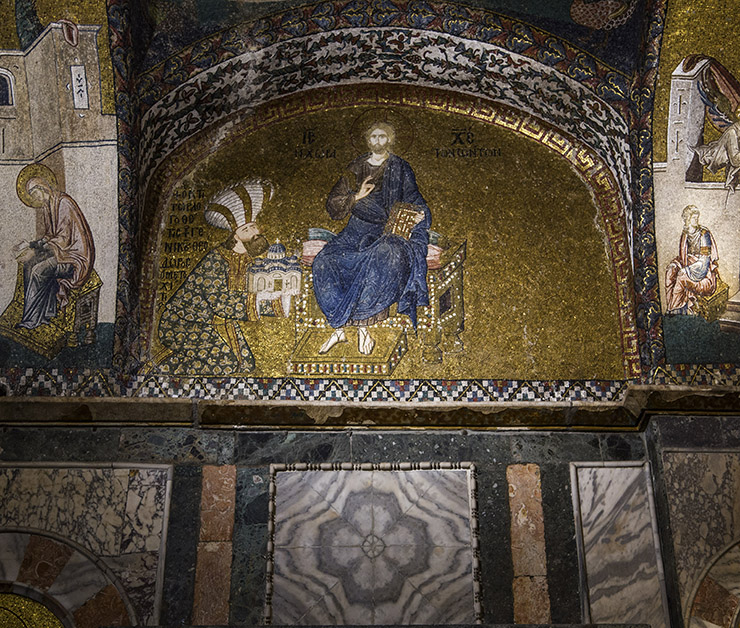 The marble revetment of the Chora is really beautiful. here's an example of a flower panel made of of four pieces of Proconnesian marble. The revetment of the Chora is laid out in curious patterns which does not always align with its architecture.
The marble revetment of the Chora is really beautiful. here's an example of a flower panel made of of four pieces of Proconnesian marble. The revetment of the Chora is laid out in curious patterns which does not always align with its architecture.
It was here in the Chora that the icon of the Virgin Hodegetria - the most famous painting in the world - was displayed during the siege of 1453. It was kept near the walls hoping it would protect the city. The Chora was the first church to be sacked by the Muslim troops. They cut the icon into pieces and gave it to Islamic soldiers as loot. They removed the precious coverings of the icon and burned what was left after urinating on it.

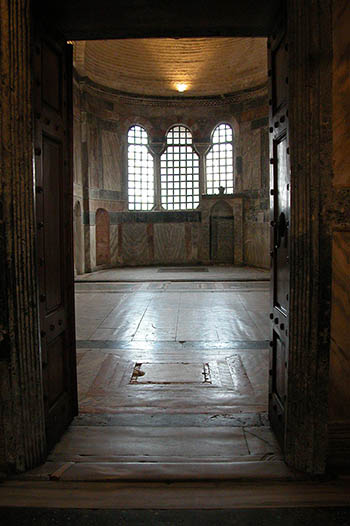
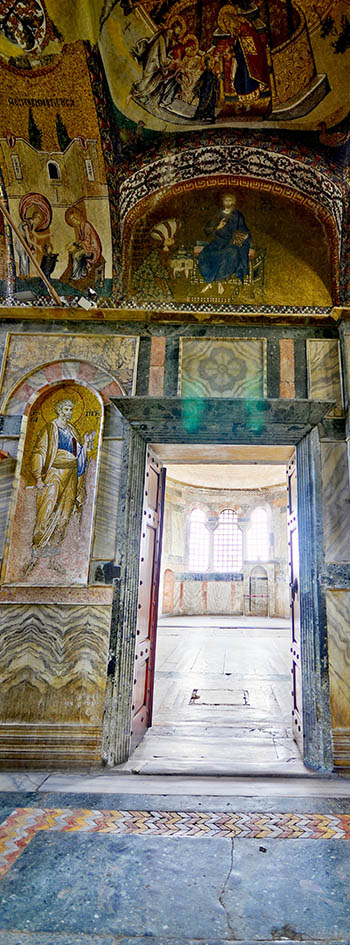
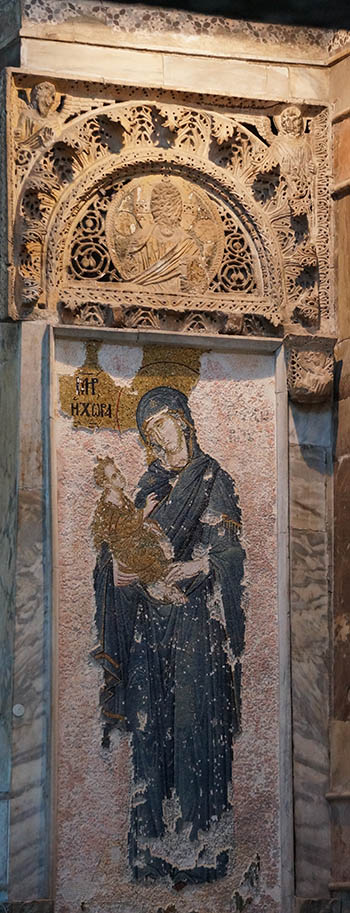 The marble carving above the icon of the Theotokos was smashed by Turkish Islamic extremists. Since the late 19th century the icon was covered with wooden shutters before the restoration. For a fee the shutters were opened. The gold around the figures of the Theotokos and Christ was sold to tourists. This was a common practice in Ottoman times.
The marble carving above the icon of the Theotokos was smashed by Turkish Islamic extremists. Since the late 19th century the icon was covered with wooden shutters before the restoration. For a fee the shutters were opened. The gold around the figures of the Theotokos and Christ was sold to tourists. This was a common practice in Ottoman times.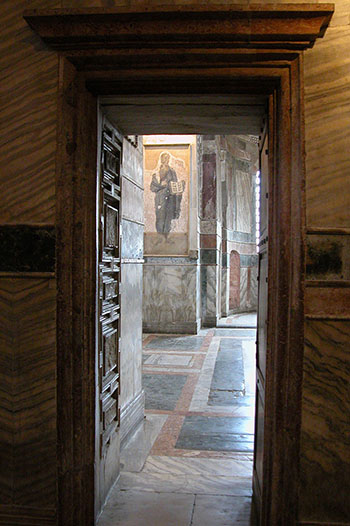
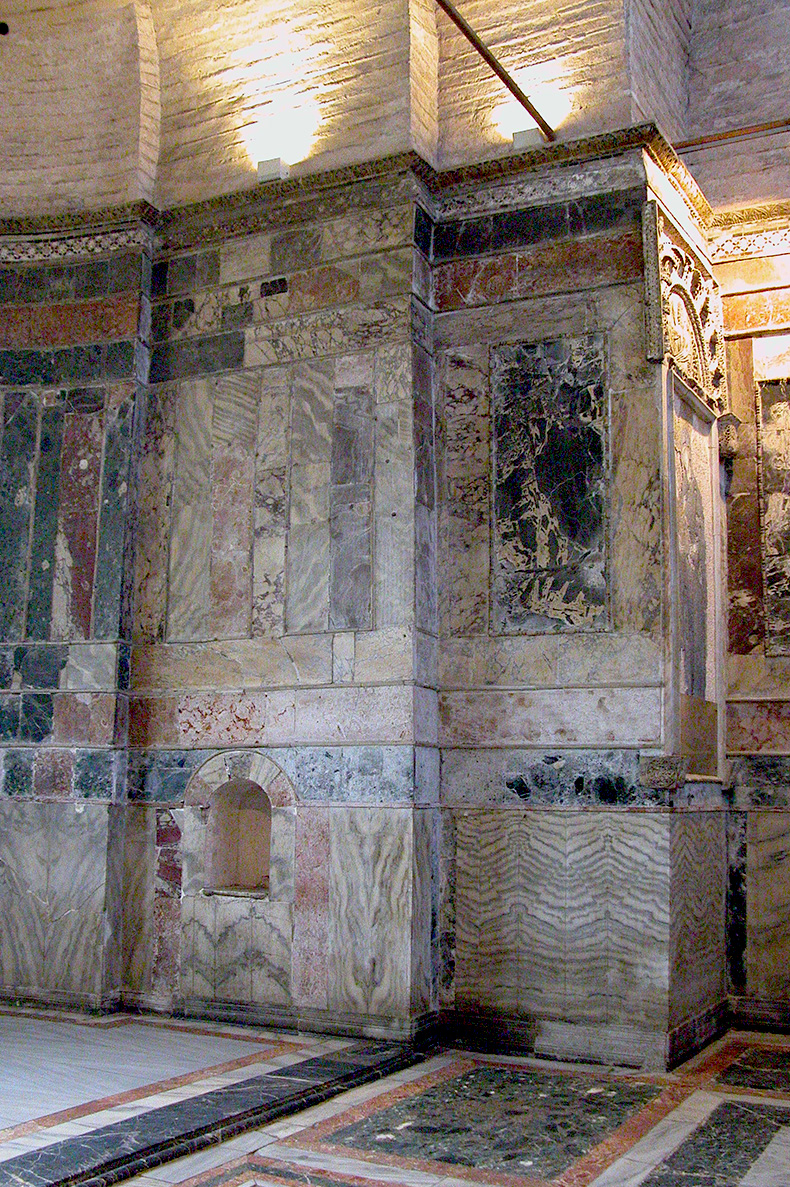
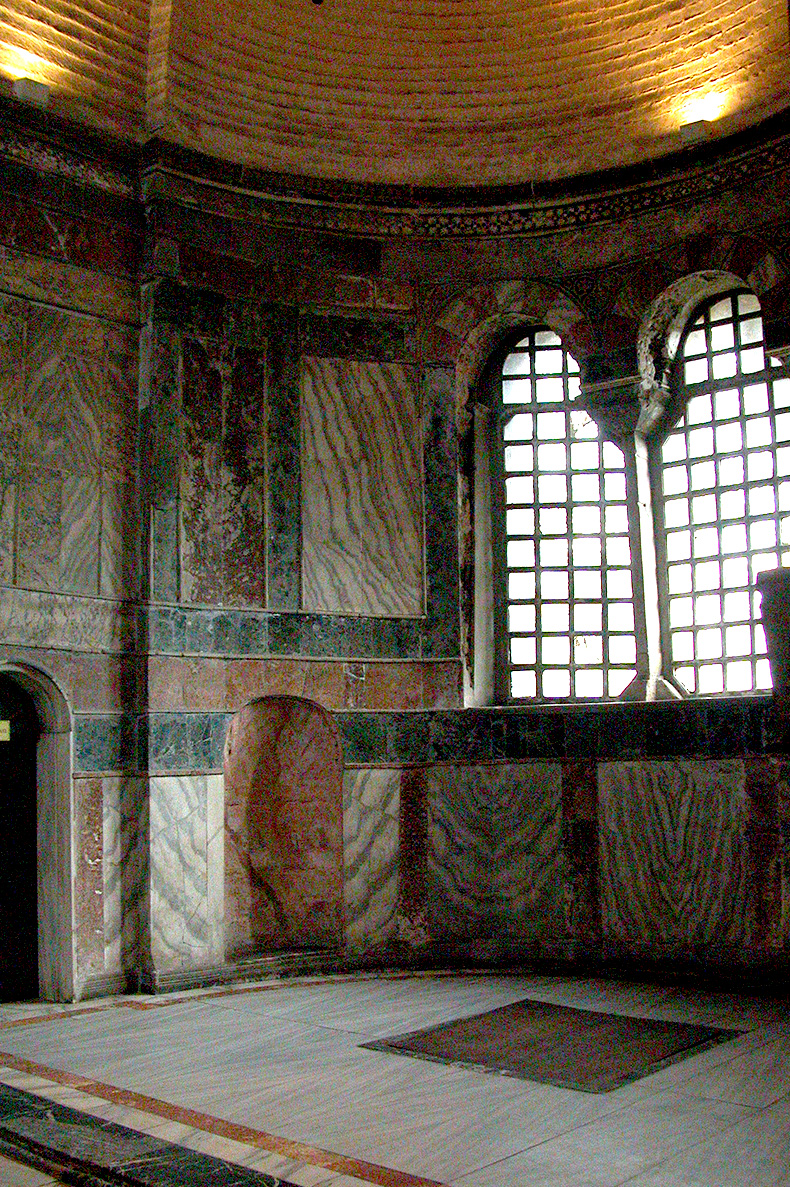
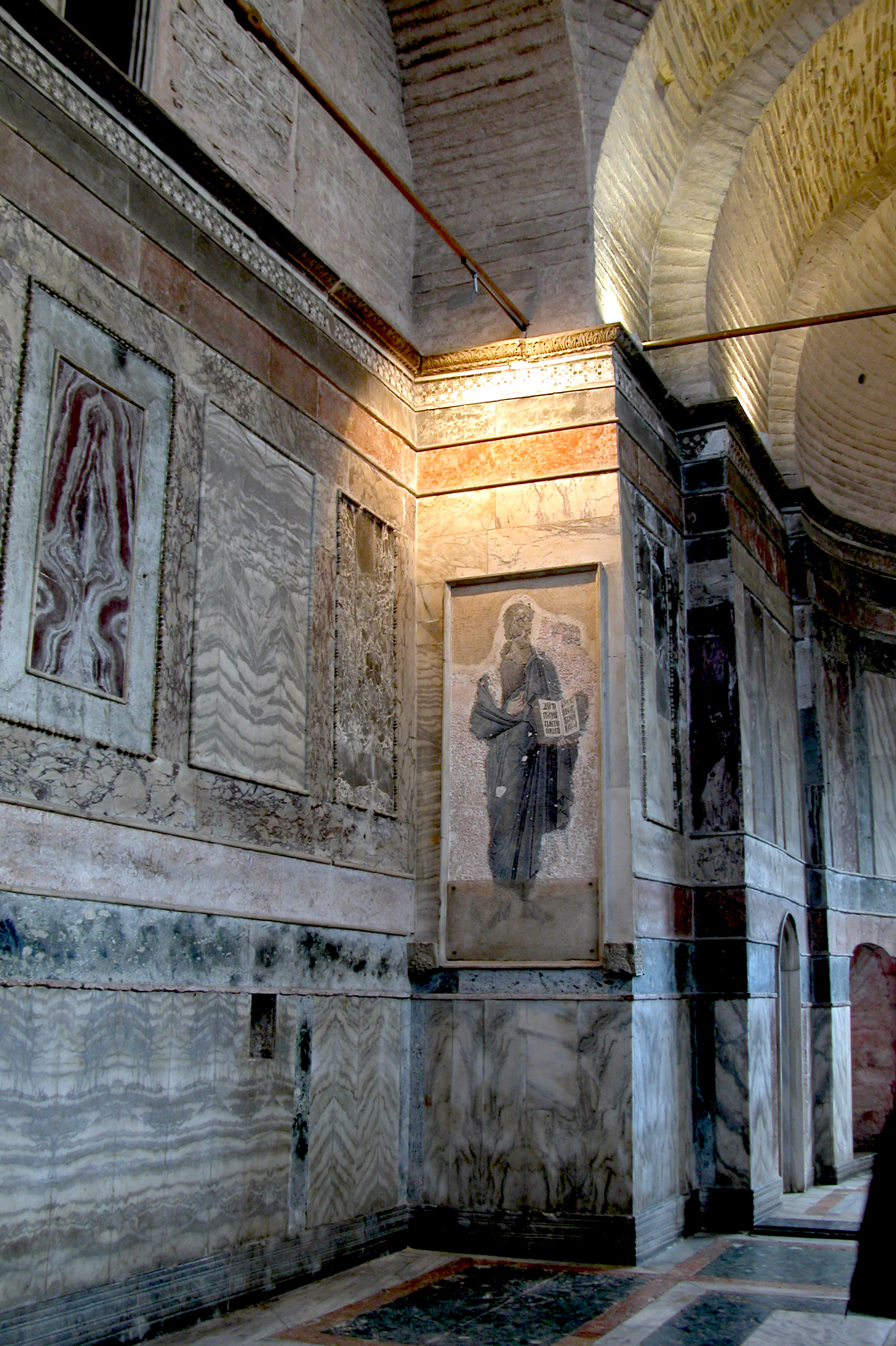
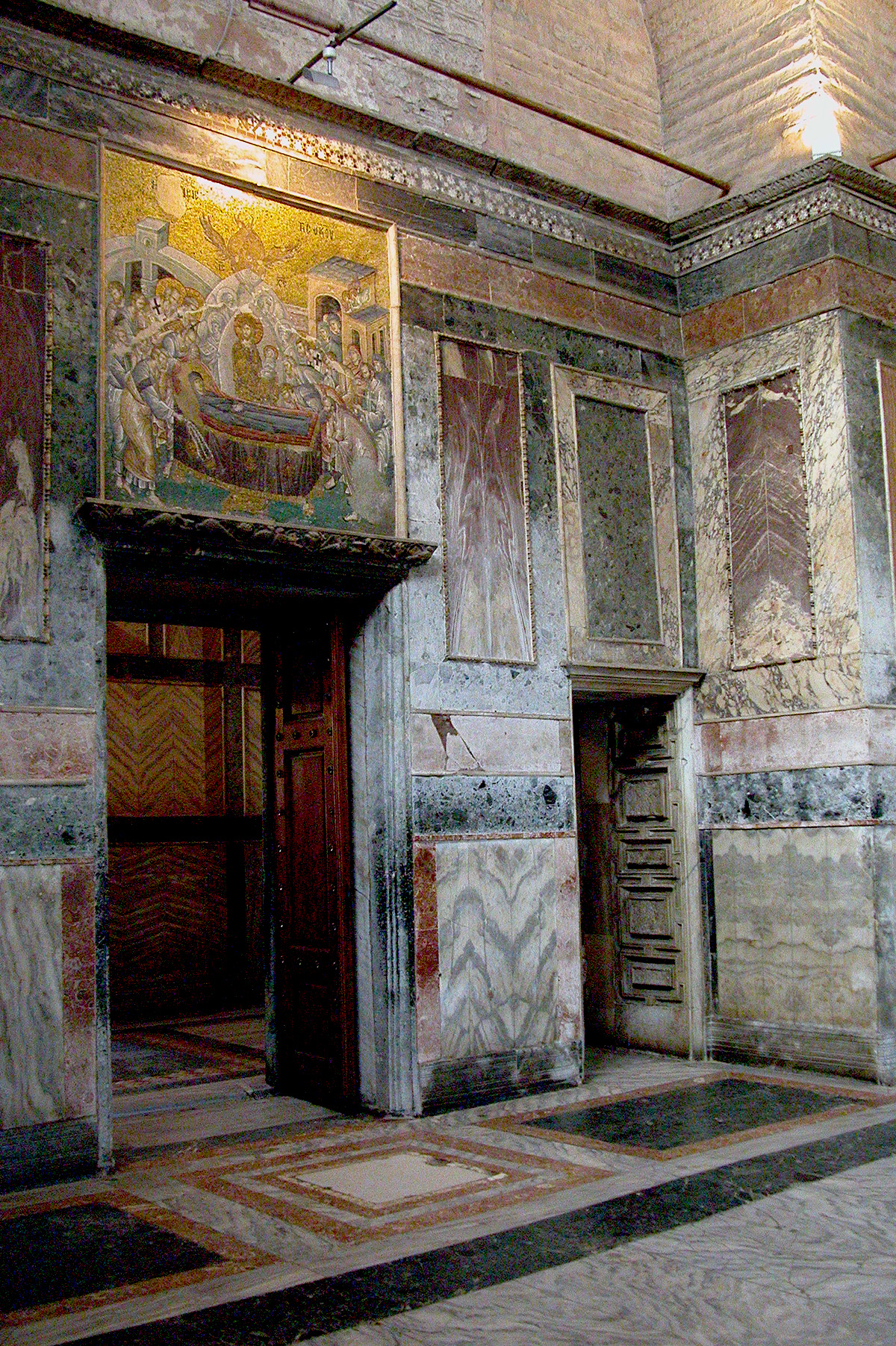
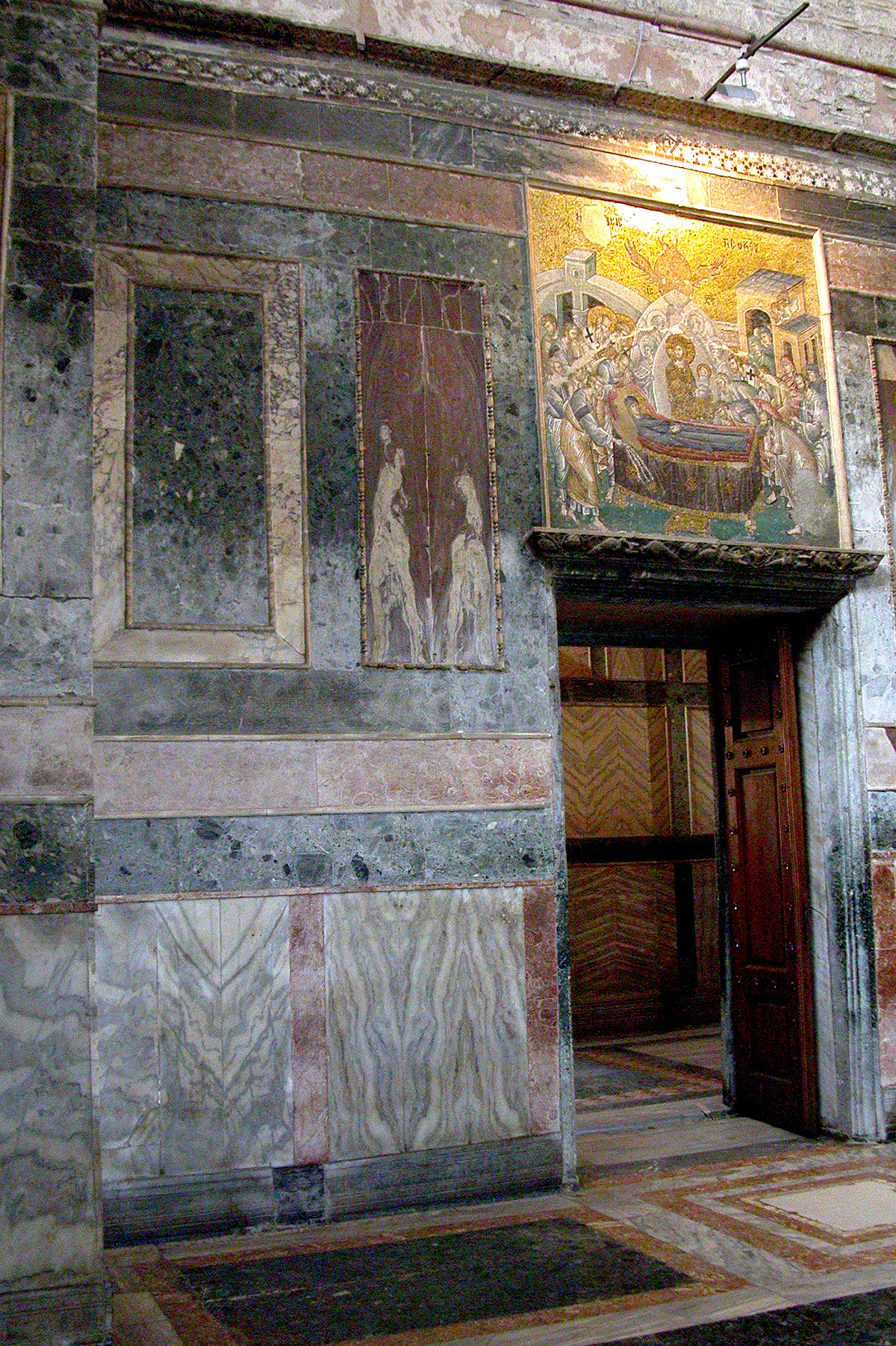
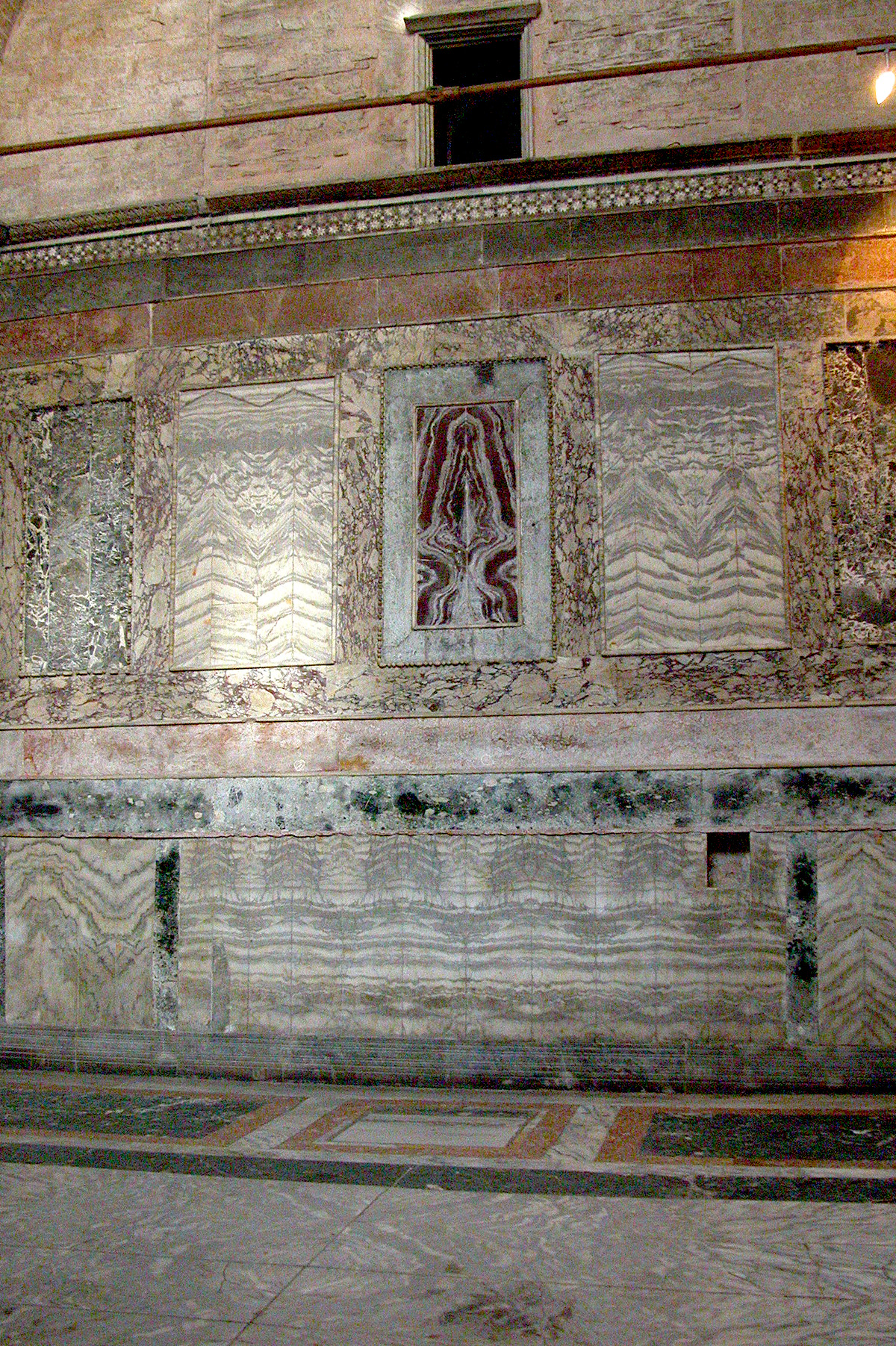 In the middle you can see a band of Verd Antique a green stone from Larissa in Greece. The marble is decaying and converting into gray talc. This is happening in Hagia Sophia, too.
In the middle you can see a band of Verd Antique a green stone from Larissa in Greece. The marble is decaying and converting into gray talc. This is happening in Hagia Sophia, too.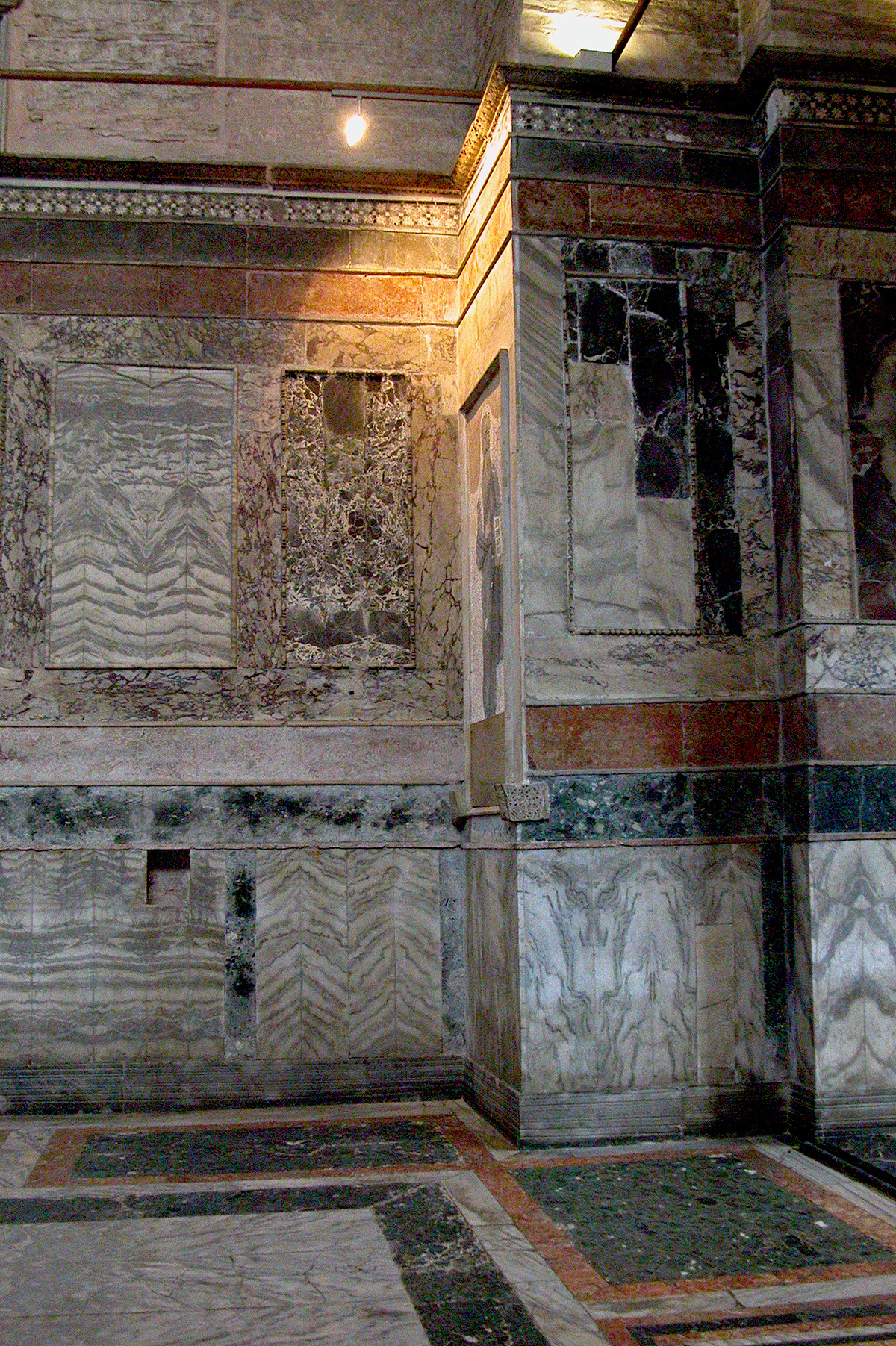 On the left you can see where the marble revetment was been disturbed. Here the iconostasis joined with the left pier. You can see how the top of it aligned with the mosaic of Christ. The iconostasis was removed when the church was converted into a mosque.
On the left you can see where the marble revetment was been disturbed. Here the iconostasis joined with the left pier. You can see how the top of it aligned with the mosaic of Christ. The iconostasis was removed when the church was converted into a mosque.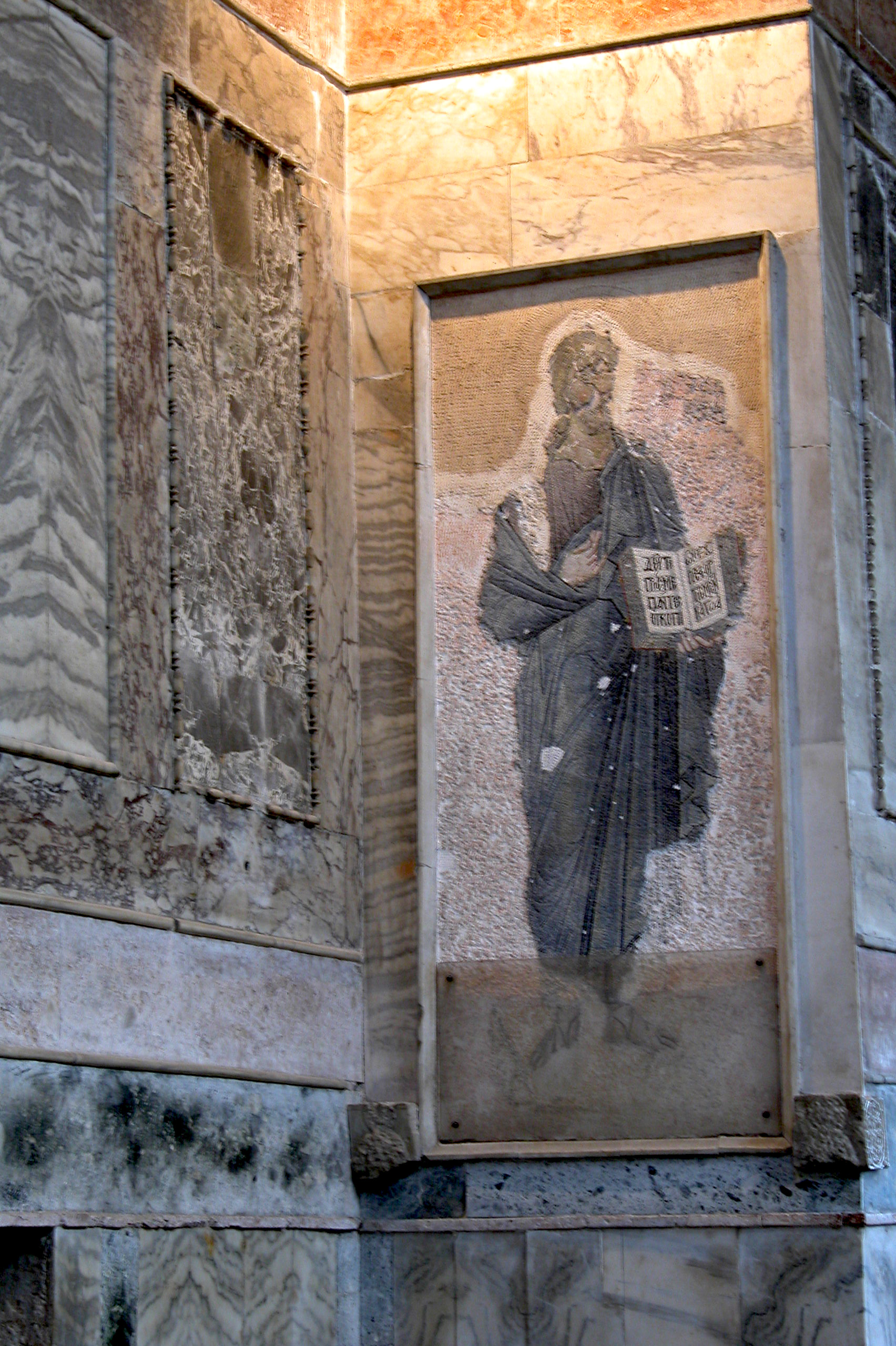
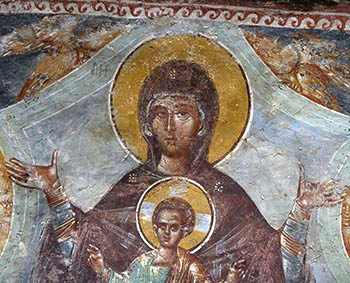
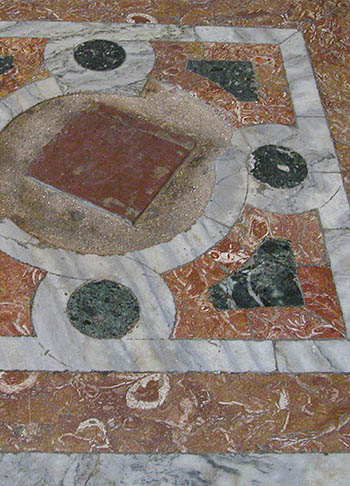

 There are a number of images of Christ in the Chora Church, which was dedicated to Christ. The monastery attached to it was dedicated to His mother, the Theotokos. The first mosaics were done in the naos and the work then out into the narthexes. From the work in the naos three panels have survived. Stylistically the work in the main church was the most conservative and it became more mannered - even eccentric - as the artists progressed. It seems that the "iconic" mosaics - like the Pantokrators (Christ is very solid and realistic here) and full length saints - were the most calm and 'classical' in their poses. Even in these one can detect manneristic trends like the broadly spaced fingers in the hand holding the gospel above. Many of the scenes from the lives of Christ and the Theotokos include odd figures in distorted poses that are pasted together like Byzantine clip-art or paper-dolls. These artists must have had sketch books or illustrated books as guides that they picked and chose figures from. One can visualize Theodore and his artists working out the plan and then making adjustments as they were putting up the designs in fresco and then in mosaic on the walls. This was a big, expensive project and speed was probably very important. Mosaics could only be set during the late spring and summer and its possible all of the mosaic work was done in three years.
There are a number of images of Christ in the Chora Church, which was dedicated to Christ. The monastery attached to it was dedicated to His mother, the Theotokos. The first mosaics were done in the naos and the work then out into the narthexes. From the work in the naos three panels have survived. Stylistically the work in the main church was the most conservative and it became more mannered - even eccentric - as the artists progressed. It seems that the "iconic" mosaics - like the Pantokrators (Christ is very solid and realistic here) and full length saints - were the most calm and 'classical' in their poses. Even in these one can detect manneristic trends like the broadly spaced fingers in the hand holding the gospel above. Many of the scenes from the lives of Christ and the Theotokos include odd figures in distorted poses that are pasted together like Byzantine clip-art or paper-dolls. These artists must have had sketch books or illustrated books as guides that they picked and chose figures from. One can visualize Theodore and his artists working out the plan and then making adjustments as they were putting up the designs in fresco and then in mosaic on the walls. This was a big, expensive project and speed was probably very important. Mosaics could only be set during the late spring and summer and its possible all of the mosaic work was done in three years. I have always been struck by the number of figures with blond hair in the mosaics here. 'Blond" Christ has been seen before - in Norman Sicily. I have always assumed that mosaic was not an innovation, but must have copied some Byzantine prototype in Constantinople. Was the famous image of Christ on the Chalke gate of the Great Palace fair-haired? Was there a cultural trend in Byzantium that associated blond hair with beauty and did that extend to images of Christ and the saints? Starting with the Komnenian dynasty the Emperors of Byzantium married foreign princesses who were blond. john II married the famously blond Piroska of Hungary - who was Franco-Germanic in her ancestry.We don't know how many of her children were blond, but certainly her youngest son, Manuel I, was not. His images of Christ show Him with dark hair and beard, looking like Manuel himself, no accident since Manuel's name meant "Emmanuel'- "God with us" and he emulated the physical image of Christ in his own representation. The great mosaic of the Deesis in Hagia Sophia is an example of this.
I have always been struck by the number of figures with blond hair in the mosaics here. 'Blond" Christ has been seen before - in Norman Sicily. I have always assumed that mosaic was not an innovation, but must have copied some Byzantine prototype in Constantinople. Was the famous image of Christ on the Chalke gate of the Great Palace fair-haired? Was there a cultural trend in Byzantium that associated blond hair with beauty and did that extend to images of Christ and the saints? Starting with the Komnenian dynasty the Emperors of Byzantium married foreign princesses who were blond. john II married the famously blond Piroska of Hungary - who was Franco-Germanic in her ancestry.We don't know how many of her children were blond, but certainly her youngest son, Manuel I, was not. His images of Christ show Him with dark hair and beard, looking like Manuel himself, no accident since Manuel's name meant "Emmanuel'- "God with us" and he emulated the physical image of Christ in his own representation. The great mosaic of the Deesis in Hagia Sophia is an example of this.
 Here we can see the few black lines drawn into the beard of Christ. The only other black in the face are the pupils. This is a very young Christ, with a full unlined face. The absence of black lines in the beard is one of the reasons He looks so blond. The nose is large and strongly drawn, there is a bold shadow alongside it.. The lips are pale and the lower lip projects outward. The line of the lips is boldly drawn. Normally the lines of the eyelids would be drawn in red, here there is no color in them. there is also a strong shadow on the neck.
Here we can see the few black lines drawn into the beard of Christ. The only other black in the face are the pupils. This is a very young Christ, with a full unlined face. The absence of black lines in the beard is one of the reasons He looks so blond. The nose is large and strongly drawn, there is a bold shadow alongside it.. The lips are pale and the lower lip projects outward. The line of the lips is boldly drawn. Normally the lines of the eyelids would be drawn in red, here there is no color in them. there is also a strong shadow on the neck. The eyebrows are blond, too - they are arched which makes the face look a bit menacing. notice the checkerboard shading.
The eyebrows are blond, too - they are arched which makes the face look a bit menacing. notice the checkerboard shading. Notice how the artist has used checkerboard stripes to indicate the transition between greenish glass shadows and light flesh made of marble cubes. the hands are massive and fleshy.
Notice how the artist has used checkerboard stripes to indicate the transition between greenish glass shadows and light flesh made of marble cubes. the hands are massive and fleshy. Above you can see how the highlights show up in raking light. The white cubes are matte and stand out against the surface of the rest of the face. This was intentional. The image was lit by by lamps in Byzantine times. Most of the time visitors would have seen the image in natural light.
Above you can see how the highlights show up in raking light. The white cubes are matte and stand out against the surface of the rest of the face. This was intentional. The image was lit by by lamps in Byzantine times. Most of the time visitors would have seen the image in natural light. This image of restorers working on the mosaic of the Pantokrator shows how big it is. It's similar in size to the mosaic of Christ in the gallery of Hagia Sophia. The image below shows a drawing taken directly from it. The Byzantine Institute started it's work in the Chora which continued until 1958.
This image of restorers working on the mosaic of the Pantokrator shows how big it is. It's similar in size to the mosaic of Christ in the gallery of Hagia Sophia. The image below shows a drawing taken directly from it. The Byzantine Institute started it's work in the Chora which continued until 1958. The white highlights stand out here as well.
The white highlights stand out here as well. This large - 6.5 feet tall - templon mosaic carries the inscription - "Jesus Christ, the dwelling place of the living". The gospel carries the inscription "Come unto me, all ye who labor and are heavy laden, and I will give you rest" (Matt 11:28). It is in the main body of the church and was set up on the left pier. It was originally surrounded by a marble frame or kiot that has almost entirely been removed. This mosaic icon was connected to the - now vanished - sanctuary screen of the church. It was badly damaged by Muslim extremists after the conversion of the church to a mosque after 1453. The revetment surrounding the icon was also damaged and reset. At the bottom of the kiot you can see two Byzantine marble carvings whose images of saints have been chipped away. The gold background has also been picked at for souvenirs for tourists. This practice was also prevalent in Hagia Sophia and resulted in the complete striping of gold mosaic from the Room over the Vestibule.
This large - 6.5 feet tall - templon mosaic carries the inscription - "Jesus Christ, the dwelling place of the living". The gospel carries the inscription "Come unto me, all ye who labor and are heavy laden, and I will give you rest" (Matt 11:28). It is in the main body of the church and was set up on the left pier. It was originally surrounded by a marble frame or kiot that has almost entirely been removed. This mosaic icon was connected to the - now vanished - sanctuary screen of the church. It was badly damaged by Muslim extremists after the conversion of the church to a mosque after 1453. The revetment surrounding the icon was also damaged and reset. At the bottom of the kiot you can see two Byzantine marble carvings whose images of saints have been chipped away. The gold background has also been picked at for souvenirs for tourists. This practice was also prevalent in Hagia Sophia and resulted in the complete striping of gold mosaic from the Room over the Vestibule. Here - in the much mutilated face - we can see the blond hair of Christ.
Here - in the much mutilated face - we can see the blond hair of Christ. The almost miraculous survival of the icon in its mutilated state reminds Christians of the suffering of Christ in the passion story. The deliberate attacks on the face echo the mocking and beating of Christ by Roman soldiers.
The almost miraculous survival of the icon in its mutilated state reminds Christians of the suffering of Christ in the passion story. The deliberate attacks on the face echo the mocking and beating of Christ by Roman soldiers. Above you can see a marble carving from the Chora that was a part of a kiot. It is above the mosaic of the templon Theotokos in the nave. These sculptures were originally painted and gilded. Semi-precious stones or glass was inlaid in Christ's halo. Behind the figure of Christ you can see the faded traces of blue. After the Islamic conquest of Constantinople in 1453 the face, hands and gospel of Christ were brutally chiselled away.
Above you can see a marble carving from the Chora that was a part of a kiot. It is above the mosaic of the templon Theotokos in the nave. These sculptures were originally painted and gilded. Semi-precious stones or glass was inlaid in Christ's halo. Behind the figure of Christ you can see the faded traces of blue. After the Islamic conquest of Constantinople in 1453 the face, hands and gospel of Christ were brutally chiselled away.
 Here is an image of Christ from one of the narthex domes of the church.
Here is an image of Christ from one of the narthex domes of the church. The gold mosaic in the dome glitters. The saints in the coves of the dome are the ancestors of Christ. The curve of the coves creates flames of light between them and Christ in the summit of the dome.
The gold mosaic in the dome glitters. The saints in the coves of the dome are the ancestors of Christ. The curve of the coves creates flames of light between them and Christ in the summit of the dome. Theodore Metochites was a Prime Minister - Grand Logothete of the Genekon - to Andronikos II. Here we see him presenting a model of the church to Christ Pantokrator. Theodore commissioned the decoration of the church and was closely involved in the planning of the scenes and the individual saints to be used. He was removed from power after riots in the city that ended up in the burning of his palace with all its treasures. He was forced into exile and eventually found his way back to the Chora where he became a monk taking the monastic name of Theoleptos. He died in 1332 and was buried in the tomb he had built for himself in the Chora.
Theodore Metochites was a Prime Minister - Grand Logothete of the Genekon - to Andronikos II. Here we see him presenting a model of the church to Christ Pantokrator. Theodore commissioned the decoration of the church and was closely involved in the planning of the scenes and the individual saints to be used. He was removed from power after riots in the city that ended up in the burning of his palace with all its treasures. He was forced into exile and eventually found his way back to the Chora where he became a monk taking the monastic name of Theoleptos. He died in 1332 and was buried in the tomb he had built for himself in the Chora. Theodore is wearing a silk kabbadion - kaftan - thickly embroidered with gold thread. In Theodore's time officials of the Imperial court were no longer required to wear silk uniforms of specific cut and color. You could wear what you liked as long as it was luxurious and suitable for court. Theodore wears a large silk turban called a skaidion which literally means sunshade. Even though you could pick your own clothes, hats were dictated by your position. The Byzantines invented the turban which was then taken on by the Ottomans. Theodore has a light brown beard which is cut straight across. His hair is the same color and falls in curls on his neck. Byzantine men were particular about the style and cleanliness of their hair and used scent in it.
Theodore is wearing a silk kabbadion - kaftan - thickly embroidered with gold thread. In Theodore's time officials of the Imperial court were no longer required to wear silk uniforms of specific cut and color. You could wear what you liked as long as it was luxurious and suitable for court. Theodore wears a large silk turban called a skaidion which literally means sunshade. Even though you could pick your own clothes, hats were dictated by your position. The Byzantines invented the turban which was then taken on by the Ottomans. Theodore has a light brown beard which is cut straight across. His hair is the same color and falls in curls on his neck. Byzantine men were particular about the style and cleanliness of their hair and used scent in it. The marble revetment of the Chora is really beautiful. here's an example of a flower panel made of of four pieces of Proconnesian marble. The revetment of the Chora is laid out in curious patterns which does not always align with its architecture.
The marble revetment of the Chora is really beautiful. here's an example of a flower panel made of of four pieces of Proconnesian marble. The revetment of the Chora is laid out in curious patterns which does not always align with its architecture.

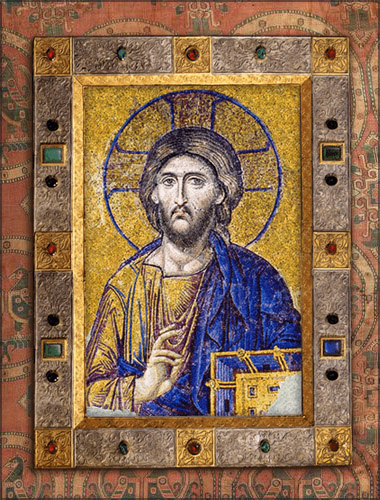

 click here for icons of christ
click here for icons of christ click here for icons of the theotokos
click here for icons of the theotokos click here for icons of angels
click here for icons of angels click here for icons of saints
click here for icons of saints








